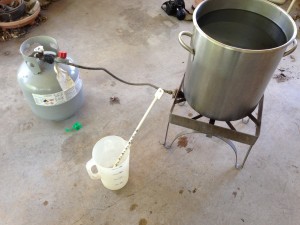
Pale ale (left) and porter (right) on Saturday. I’ve protected the fermenting beer with T-shirts over the fermenters, but took them off for the picture.
I’ve been busy lately. In November, December, and the first part of January, I was writing my first book — a collection of homebrew recipes with additional information about the techniques or ingredients featured in each recipe. I spent 9 hours a day, 6 days a week (7 near the end) writing and revising the manuscript. It’s scheduled to be published in October.
I’m biased, of course, but I think it’s going to be a useful book for homebrewers. In any case, I was excited to have the opportunity to write it and I hope everyone enjoys and benefits from it.
Two weeks ago, the photographer came out to my house and shot the pictures for the book. As part of that week, I brewed two beers, with him documenting every step. Here’s a quick recap of those brew days.
Pale Ale
I brewed my pale ale two Wednesdays ago. To brew it, I dusted off my old all-grain system. My old brewery is really just a collection of pots and a couple propane burners. I have a plain 10-gallon (38-L) Polarware pot for the kettle, a modified 10-gallon (38-L) Polarware pot — with a false bottom and a spigot — for the mash/lauter tun, and a 15.5-gallon (59-L) modified Sanke keg for the HLT. (I obtained the Sanke keg legally, BTW.) Just a basic three-vessel setup, albeit without a stand for everything sit on. I’ve brewed close to 300 batches on that setup.
The brewday went very smoothly. Even though I hadn’t used this equipment for awhile, it was like riding a bike — I remembered all the nuances. And even though the “real” purpose of the brewday was to get a bunch of photos, I also yielded 5.0 gallons (19 L) of pale ale. I’m going to dry hop it today and bottle it after 7 to 10 days.
To me, the Wednesday brew day highlighted the fact that you don’t need a fancy rig to make great homebrew. For the first time, I also used the new White Labs yeast package, which seems like a cool idea to me.
Porter
I also have a fancy rig — and I used that the next day to brew my porter. My fancy rig is a MoreBeer 1550 (the one with the “tippy dump” mash tun). Although I was working on nicer equipment, this brew day did not go as well. When I woke up Thursday, I felt sick, and I got progressively worse during the day. (I later figured out that I was dehydrated from 4 days of running around in the Texas sun, which can get you even in February. I’m used to sitting in front of a computer all day.) About midway though the brewday, I started looking for ways to speed things up. The point of the day, after all, was to get pictures for my book. So, I decided to speed up wort collection and ran the wort off fairly quickly as I was sparging. At the time, I said to myself, “This will probably hurt my extract efficiency,” but I went ahead and did it anyway. And guess what? I was right. My extract efficiency suffered.
Lunch that day made me feel a bit better and I finished the rest of the brewday without cutting any corners and yielded about 4.5 gallons (17 L) of porter at slightly lower than my target OG. The wort tasted good, though, and it should yield good beer. I’ll bottle it early next week and find out. So basically, despite feeling under the weather and dealing with being photographed as I brewed, I still managed to brew a porter. (I even retroactively excused the low efficiency by rationalizing that, since I didn’t have time to make a yeast starter, a lower original gravity would actually yield better beer. And indeed, I pitched Wyeast 1968 from a smack pack and the fermentation went well. I am also good at rationalizing reasons to have another beer.)
Future Brew Days and Experiment
I chose my pale ale and porter for those two brew days as they are my most-brewed beers. I’ve made them each over 30 times. While I was at the homebrew shop getting ingredients for those two, I also got ingredients for two more batches of beer. I decided I wanted to experiment with my copper ale a bit and got two batches of ingredients — one with 15% wheat in the grist and the other with the usual all barley malt formulation. I further decided to split each batch and ferment half with Fermentis US-05 yeast and the other half with Danstar Nottingham ale yeast.
Recipe refinement is something I almost continually do whenever I brew one of my favorite beers. I would urge every homebrewer to pick one or more recipes, based on how often they brew, and refine them. Develop your own “house” beer. The lessons you learn from brewing all sorts of different beers are important, but the lessons you learn from repeating the same beer — with small tweaks — will also help you grow as a homebrewer.
I’m not sure when I will brew these beers. I’m going to New Zealand in a couple weeks to speak at the first New Zealand National Homebrew Conference. I was psyched to be asked to attend and I hope I can say something worthwhile while I’m there. (If my talks are recorded, I’ll see if I can post them on YouTube.)
—
Related Articles


Speak Your Mind